As an Amazon Associate I earn from qualifying purchases
When mounting a soundbar below your TV, it’s advisable to leave about 10-15 cm (4 – 6 inches) of space between the bottom of the TV and the top of the soundbar.
This spacing ensures that there is minimal interference with the IR sensor of the TV and the soundbar itself, while maintaining a clean aesthetic for your setup.
Proper mounting of the soundbar not only enhances the visual appeal but also optimizes your audio experience.
The position of the soundbar can affect its performance; thus, ensuring it is placed correctly relative to your TV and seating area is crucial.
Some soundbars may have specific requirements due to their design and how they project sound, like upward-firing speakers that work best with a particular orientation.
Considering the room’s acoustics and layout is important when mounting your soundbar.
Make sure the soundbar is at an ear-level height from your usual listening position to ensure you get the richest audio experience.
Determining the Optimal Distance for Soundbar Installation

When mounting your soundbar, it’s crucial to consider the distance from your TV to ensure the best audio experience.
Understanding Soundbar to TV Distance
For a soundbar placement that enhances your listening experience, the distance between your wall-mounted TV and the soundbar is significant.
Ideally, your soundbar should be mounted directly below the TV.
TV height and ear level are the benchmarks for correct soundbar placement.
Measuring and Adjusting for Best Sound
Start by measuring the distance from the bottom of your TV to ear level while seated.
Aim for a gap of 10-15 cm (4-6 inches) between your TV and the soundbar to maintain a clear path of sound to your listening position, as this range is often accepted as an optimal distance for creating an immersive sound experience.
Ideally, after the installation, sit in your preferred spot and play a variety of audio content to test the sound quality.
If the sound seems to be originating from below the screen or does not sync well with the visuals, consider adjusting the distance or height of the soundbar slightly to improve the experience.
Best Practices for Mounting Your Soundbar

When mounting your soundbar, selecting the appropriate hardware is crucial.
Selecting the Right Mounting Hardware
To securely attach your soundbar to the wall, you need to choose the right brackets and mounting hardware.
Make sure the hardware is compatible with both your soundbar’s design and the wall material.
Use sturdy brackets or a universal soundbar mount (affiliate link) that can support the weight of your soundbar and include screws and anchors appropriate for the wall, whether it’s drywall, brick, or another type.
For compatibility, check the manufacturer’s recommendations as they often provide guidelines on the hardware for proper installation.
If you do not want to drill holes in your wall there are alternatives, I encourage you to read the article I wrote about how to mount a soundbar without drilling.
Here is the product I recommended using in that article, the no-stud hangman (affiliate link).
- Universal Design - Can hold soundbars up to - 30LBS
- Easy To Install – soundbar mounting bracket under tv Easily Pair your L-bracket soundbar wall mount and secure your soundbar
- Better Sound – Enjoy sound that projects through the room with greater clarity. Your soundbar bracket is here to maximize the punchy fidelity of your speaker while freeing up space on your TV stand.
Hangman SBH-6 No-Stud Soundbar Hanger
- Works with most soundbars up to 4.2 in. deep and 16 in. long and up
- Holds up to 50 lbs.
- 10 minute installation
- No drills, no anchors, and no damage
- Made of aircraft-grade aluminum
Achieving the Perfect Height and Level
The ideal height for your soundbar is at ear level, which typically means it should be mounted close to the bottom edge of the TV if the TV is at or around eye level.
Use a level to ensure that the soundbar is perfectly horizontal; this is not simply for aesthetic reasons but can also affect sound projection.
When determining the height, consider the furniture and the typical viewing position in the room.
Remember that the aim is to align the soundbar as close to ear level as possible, which often means about 10 inches below the TV, to ensure you get the best audio experience from your setup.
Ensuring Aesthetic Appeal and Functionality
When mounting your soundbar, achieving a balance between visual appeal and sound quality is crucial.
The placement should enhance your home theater setup without compromising functionality.
Managing Cables and Controls
To maintain aesthetics and functionality, managing cables is essential. You want to effectively hide soundbar wires if you can.
Use cable management systems (affiliate link) to keep HDMI cables and power cords out of sight, which will prevent the layout from looking cluttered.
Ensure your soundbar location allows easy access to controls and does not obstruct the TV’s remote sensor.
Strategically routing cables, possibly through the wall or by using a channel that blends with the environment, can also help in avoiding an unsightly tangle of wires.
- Tip: When using a fireplace, make sure cables are routed away from heat sources and are not visible, as this can detract from the visual appeal.
Balancing Visual Elements with Soundbar Location
The soundbar should complement your TV and the room layout. Consider the aesthetics of the room; the soundbar should be centered with the TV to create a symmetrical and visually appealing home theater.
- Note: Avoid placing the soundbar in a way that it overshadows the TV speakers or introduces remote sensor blocking issues.
Troubleshooting Common Soundbar Setup Issues
When installing a soundbar below your TV, you may encounter several acoustic challenges and interference issues that can affect sound quality.
Proper troubleshooting is key to ensuring clear audio without distortion or unwanted echo.
Addressing Acoustic Challenges and Interference
- Acoustic Challenges: Your room’s acoustics play a significant role in sound quality. Hard surfaces can cause the sound to bounce, leading to echo. To mitigate this, consider placing carpets or curtains in the room, which can absorb sound waves and improve audio clarity by dampening reverberation.
- Sensor Interference: Some soundbars come with remote sensors. Ensure that there are no obstructions blocking these sensors when mounted below the TV, as this might hinder remote functionality.
- Sound Projection: Soundbars are designed to project sound in a specific pattern. Mounting height should be such that the sound projects directly towards the listener’s ear level. If mounted incorrectly, the sound may either hit the ceiling or the floor, affecting the overall auditory experience.
- Obstruction Trouble: Furniture or other objects placed between the soundbar and the listening area can block or deflect sound, leading to sound obstruction issues. Aim for a clear path from the soundbar to your ears for optimal sound projection.
Remember, troubleshooting involves identifying the problem, applying a solution, and then re-evaluating the sound. Adjustments can include moving the soundbar, altering room elements, or reconfiguring sound settings until the desired audio quality is achieved.



